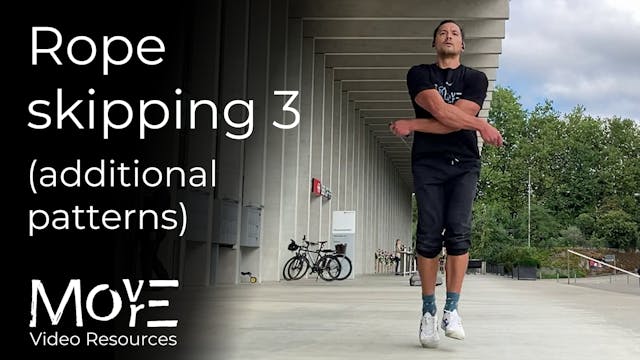Rope skipping 2: moving in space
Lower-body elasticity
•
2m 45s
THE WHAT:
5 progressive contexts for consolidating movement through space and developing dexterity with the skipping rope. They include linear (forward/back, left/right) & circular patterns, as well as changing of stance to a staggered position for better emulation of fighting/athletic contexts.
Resource contents:
0:05 - A1. Forward & backward (lengths)
0:25 - A2. Square' stance (stationary)
1:00 - A3. Square' stance (forward & back)
1:14 - A4. Lateral skipping (left/right) & 'spring-step'
2:03 - A5. Skipping circles (left/right)
As moving through space & changing direction affects the pull of the rope (particularly in the 'circles' pattern), each pattern/direction requires a unique on-the-fly executional adjustment (such as slight re-positioning of the hands & magnitude of pull) to avoid breaking the set.
MILESTONES:
- 60" unbroken skipping with each pattern
- 3' minutes unbroken skipping, integrating all patterns
___________________
For programming, guidance, & support for your physical practice:
The 'Video Resource Library' (VRL): https://www.movemorevrl.com/browse
FREE fundamental prehabilitation program: https://www.movemoremp.com
Online Support (1 to 1 coaching): https://movemoremp.com/onlinesupport
Elements (standardised programs): https://www.movemoremp.com/elements
[email protected]
Up Next in Lower-body elasticity
-
Basic rope-skipping 3: Additional pat...
THE WHAT:
4 additional patterns which include variations with the arms and skipping in reverse. Regardless, the basic 'unilateral weight-shift' remains the same.Resource contents:
0:05 - Double-side "whips"
MILESTONE: 60" unbroken skipping, increasing frequency of whips to 2 whips (1 each side)... -
Single-leg balance (SLB) & ('dynamic'...
THE WHAT:
Applying fundamental principles of "emptying" and 'force-generation & transmission' to expression in the legs. Conceptually, it is no different to expression in the arms, and so, toward and embodied understanding of the underlying CONCEPTS ,the practitioner should strive to notice the T... -
Single-leg (SL) 'Figure-8' (F8) / 3-l...
THE WHAT:
A most fundamental single-leg (SL) balance context in which the universal 'figure-8' (F8) is used as a frame to develop patterning, proprioception, and structural adaptability on one leg. As a 'side-effect', the process of practice will also develop physiological capacities toward impro...



